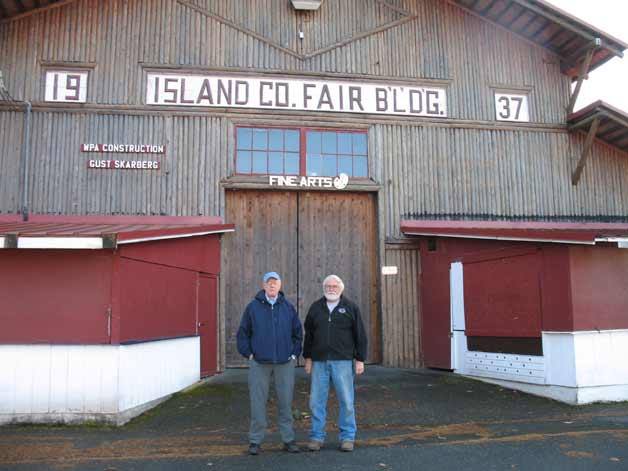For nearly 75 years, the Pole Building at the Island County Fairgrounds has been the first building fairgoers encountered when they passed through the gates. Recently, the iconic Pole Building and 13 other rustic barns on the fairgrounds were named to the Washington State Heritage Barn Registry.
The Island County Fairgrounds is the first in the state to have all its barns listed on the Washington State Registry.
“I believe it’s the first fairgrounds in the country to have all its buildings nominated,” said Harrison Goodall, local historian and Island County Historical Museum board member who was instrumental in having the fair buildings named to the Washington Heritage Barn Registry.
Goodall has worked to have several local barns named to the Heritage Barn Registry, including the Oak Harbor Roller Barn, The Comstock Barn on Ebey’s Prairie, and the Smith Barn at Willowood Farm.
“I think I’ve nominated about 50 local barns for the honor,” said Goodall. “I’m interested in preserving the rural historic landscape. Unless steps are taken to preserve rural buildings, they’re going to disappear.”
In order to be considered, agricultural buildings need to have been built prior to 1960.
While there are no restrictions made on the nominated barns’ owners, Goodall said the intent of the Heritage Barn program is to honor the building and to encourage preservation.
“A positive result of getting a building named to the registry is that the owners will then be encouraged to preserve and take care of them,” said Goodall. “Some of the barns on Ebey’s Prairie have been named to the state historic register, and some owners have received state grants for restoration and preservation efforts.”
South Whidbey Historical Society member Bob Waterman said the Island County Fair is one of the oldest in Washington state.
“It was originally held in Coupeville starting in 1912, then it was relocated to Langley in 1917, and was held at the Langley marina from 1917 to 1922,” said Waterman. “They had exhibits in the dance pavilion there.”
After the marina was sold, the fair moved to the high school grounds until the current site was purchased.
In 1934, local builder Al Melsen advanced the fair association $300 for the six-acre chicken ranch on the fairgrounds’ current site. Seven more acres were eventually added.
The Pole Building was the first building on the new fair site.
In 1935, the WPA (Works Progress Administration) paid for materials and local labor to build the then-largest pole structure in the U.S. The construction of the Pole Building provided employment to local workers for almost two years.
The WPA put millions of Americans to work building capital projects such as roads and public buildings in communities across the country.
“There’s an extraordinary quality of craftsmanship in these buildings. The builders took care in their design and implementation,” said Goodall.
“The Pole Building is historically significant both for its connection with the WPA and the fair, an important part of the Whidbey Island community for more than a century,” Goodall continued.
Using mainly native materials such as peeled fir poles, Pole Building workers raised the walls and spanned a large open space with log trusses.
The river rock chimney, which once was used for the kitchen’s wood cook stove, features a small star pattern in the upper portion.
A rustic wooden chandelier lights the auditorium space.
Today the Pole Building, renamed for fair manager Gust Skarberg in 2001, accommodates the Whidbey Island fair offices, a large auditorium, smaller multipurpose rooms and storage areas and an independent small theatre.
Currently, the Whidbey Island Fair Association is sponsoring a fund drive to restore and renovate the Pole Building’s kitchen to make it more appealing as a year-round, community gathering place.
Fair Administrator Sandey Brandon said, “The Island County Fair Association received a $50,000 grant from the Washington State Department of Agriculture to upgrade the kitchen’s infrastructure, but we need to raise $75,000 more from the community for appliances, cabinets and fixtures.”
“It’s an honor to have these historic buildings put on the registry, and it makes us more determined to preserve and protect them,” said Brandon. “We’re all stewards of our fair buildings.”


